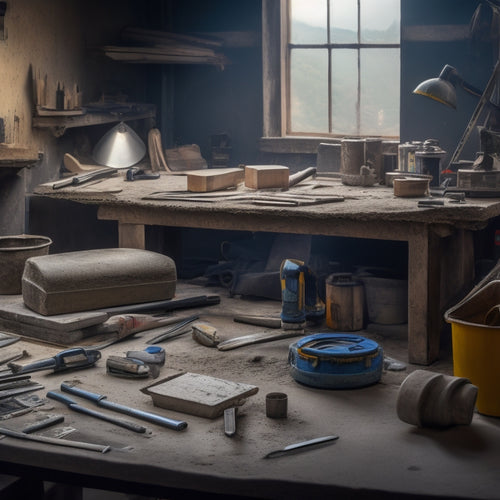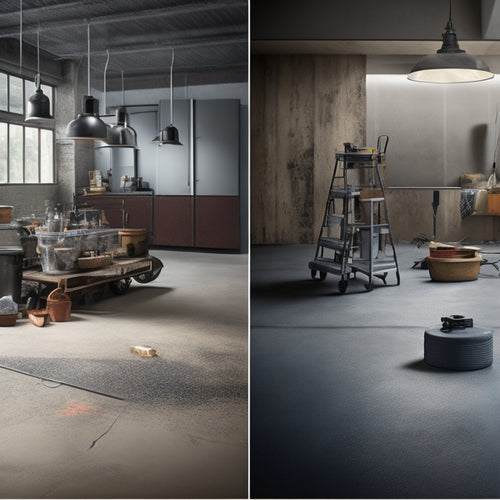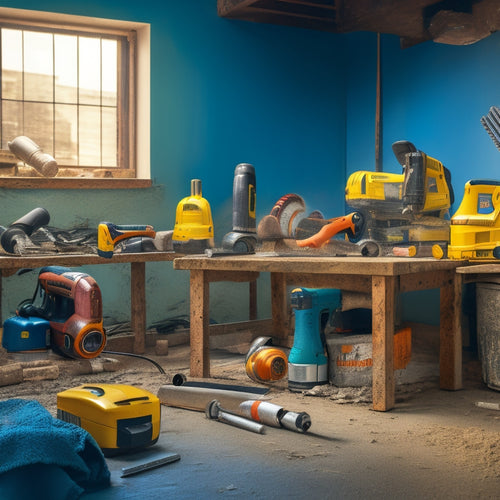
Essential Tools for Concrete Finishing Beginners
Share
As a concrete finishing beginner, you'll need to invest in a range of essential tools to achieve professional-looking results. A high-quality trowel is a must-have for achieving a smooth, even surface, while an edger creates clean, defined edges along various surfaces. You'll also need floats, jointers, and other hand tools to smooth and flatten concrete, as well as power tools like walk-behind trowels and concrete grinders for larger projects. Don't forget to prioritize safety gear, including durable clothing, steel-toed boots, and protective eyewear. With these tools at your disposal, you'll be well-equipped to tackle concrete finishing projects and open up a world of possibilities.
Key Takeaways
• A high-quality trowel is essential for achieving a smooth, even surface in concrete finishing.
• Edgers and jointers are critical for creating clean, defined edges and precise joints in concrete surfaces.
• Power tools like walk-behind trowels, ride-on power trowels, and concrete grinders are necessary for smoothing and preparing surfaces.
• Safety gear, including durable clothing, steel-toed boots, goggles, and dust masks, is crucial for protecting beginners from hazards on-site.
• Mastering hand tools and techniques requires practice and patience to achieve professional-looking results in concrete finishing.
Concrete Finishing Tool Essentials
You'll need a solid foundation of essential tools to achieve a professional-looking finish, and a trowel is the first item to add to your concrete finishing arsenal. A high-quality trowel will help you achieve a smooth, even surface, and mastering trowel techniques is vital for a successful finish.
When selecting a trowel, look for one with a sturdy handle and a blade made from durable, rust-resistant materials.
As you begin working with your trowel, keep in mind these finishing tips: hold the trowel at a 45-degree angle, applying gentle to moderate pressure depending on the stage of the concrete. Use long, sweeping strokes to spread the concrete evenly, then switch to shorter strokes to remove excess material.
Remember to keep your trowel clean and well-lubricated to prevent concrete from sticking to the blade. By mastering these fundamental trowel techniques, you'll be well on your way to achieving a professional-looking finish. With practice and patience, you'll develop the skills and confidence to tackle even the most complex concrete finishing projects.
Hand Tools for Finishing Concrete
Finishing concrete by hand requires a range of specialized tools, including edgers, jointers, and floats, which work in tandem to refine the surface and create a polished finish. As you work on your concrete project, you'll need these hand tools to achieve the desired surface textures and trowel techniques.
Here are three essential hand tools you'll need to get started:
-
Edger: Used to create a clean, defined edge along walls, curbs, and other obstructions. Edgers come in various sizes and shapes to fit different applications.
-
Float: A flat, rectangular tool used to smooth and flatten the concrete surface. Floats are available in magnesium, aluminum, or resin materials, each with its own advantages.
-
Jointer: A long, straight tool used to create control joints in the concrete, which help control cracking and promote a more even finish.
Mastering the use of these hand tools will take practice, but with patience and dedication, you'll be able to achieve professional-looking results. By combining the right techniques with the right tools, you'll be able to create a beautiful, durable concrete finish that will last for years to come.
Power Tools for Smoothing
Power Tools for Smoothing
Switch to power tools for the heavy lifting, and let machines like walk-behind trowels, ride-on power trowels, and concrete polishers take over to smooth and refine your concrete surface. These power tools will help you achieve a high-gloss finish, remove imperfections, and increase the overall durability of your concrete.
| Tool | Description |
|---|---|
| Walk-Behind Trowels | Ideal for small to medium-sized areas, these trowels provide a smooth finish and are easy to maneuver. |
| Ride-On Power Trowels | Suitable for large areas, these trowels offer increased productivity and are perfect for commercial projects. |
| Concrete Grinders | Used for removing old coatings, grinding down high spots, and preparing surfaces for polishing. |
| Concrete Polishers | Designed for high-gloss finishes, these polishers use progressively finer abrasives to achieve a mirror-like finish. |
When choosing power tools for smoothing, consider the size of your project, the level of finish you want to achieve, and the type of concrete you're working with. By selecting the right tool for the job, you'll be able to achieve professional-looking results with ease. With practice and patience, you'll be able to master the art of concrete finishing and take your projects to the next level.
Edging and Jointing Tools
What sets a professional concrete finish apart from an amateur one is the attention to detail in the edges and joints, where specialized tools come into play to create clean lines, crisp joints, and a seamless finish.
As you work on perfecting your edging techniques, you'll find that the right tools make all the difference.
-
Edger: A must-have for creating sharp, defined edges, an edger helps you achieve a clean, professional-looking finish. Choose from manual or powered edgers, depending on the size of your project and your personal preference.
-
Jointing trowel: For creating precise, uniform joints, a jointing trowel is essential. Its flat, broad blade allows you to spread jointing materials evenly, ensuring a strong bond between slabs.
-
Jointing material applicator: This tool simplifies the process of applying jointing materials, such as silicone or polyurethane sealants, to create a watertight seal. Look for an applicator with adjustable flow control for precise application.
Safety Gear for Beginners
As you begin your concrete finishing journey, equipping yourself with the right safety gear is crucial to protecting your health and preventing injuries on the job site. You can't afford to take safety lightly, especially when working with a material as unforgiving as concrete.
First and foremost, you'll need proper attire. Invest in durable, long-sleeved shirts and pants to shield your skin from concrete splatters and abrasions. Steel-toed boots with slip-resistant soles are also essential for preventing foot injuries. Don't forget to add a pair of knee-high rubber boots to your arsenal, as they'll keep your feet dry and protected from concrete washouts.
Next, focus on safety precautions. Wear goggles or safety glasses to protect your eyes from flying debris and chemical splashes. A dust mask or respirator will help you breathe safely when working with dusty or hazardous materials.
Frequently Asked Questions
What Is the Ideal Temperature for Finishing Concrete?
When you're working with concrete, you'll want to pay close attention to the temperature, as it drastically affects the finishing process.
Ideally, you're aiming for a temperature between 50°F and 70°F (10°C to 21°C) for ideal results. If it's too hot, you'll struggle with rapid drying, while cold temperatures slow down the setting process.
Can I Finish Concrete During Rainy Weather?
When you're planning to finish concrete, rainy weather isn't ideal.
You'll face challenges like slower setting times, reduced strength, and increased risk of defects.
In rainy conditions, it's essential to adapt your finishing techniques to compensate.
You'll need to adjust your troweling and floating techniques to prevent water from pooling on the surface.
Additionally, consider using specialized products to accelerate setting and improve durability.
Don't let rainy weather compromise your results – adjust your approach to achieve a high-quality finish.
How Do I Remove Old Concrete to Redo a Surface?
You're wondering how to remove old concrete to redo a surface.
It's a common myth that old concrete can't be removed without damaging the underlying structure.
But, in reality, with the right techniques, you can successfully remove old concrete and prepare the surface for a new finish.
You'll need to employ concrete removal techniques like jackhammering, grinding, or chemical demolition.
Then, follow surface preparation tips like cleaning, profiling, and testing to guarantee a strong bond between the old and new concrete.
What Is the Best Way to Learn Concrete Finishing Skills?
To master concrete finishing skills, you'll want to combine theoretical knowledge with hands-on practice.
You can start by taking online courses to learn the fundamentals, such as surface preparation and finishing techniques.
Then, sign up for hands-on workshops where you can practice under the guidance of experienced professionals.
This blended approach will help you develop muscle memory and confidence in your skills, allowing you to take control of your concrete finishing projects.
Do I Need to Seal Concrete After Finishing?
You're wondering if sealing concrete is a must after finishing.
Let's get straight to it: yes, you should seal your concrete. It's like adding the cherry on top - it enhances the appearance and durability.
You've got various sealing options, from acrylic and epoxy to polyurethane and silane.
Sealing benefits include protection from stains, improved resistance to wear and tear, and easier maintenance.
Conclusion
As you commence your concrete finishing journey, remember that having the right tools is just the beginning.
With these essentials in your arsenal, you'll be well on your way to crafting surfaces as smooth as a summer breeze and as resilient as the Colosseum's ancient walls.
Now, go forth and conquer the world of concrete, one finishing task at a time!
Related Posts
-

3 Best Hand Tools for DIY Concrete Construction
When tackling a DIY concrete construction project, you'll need three essential hand tools to achieve a professional-l...
-

Top Tools for Revamping Old Concrete Floors
You'll need a range of tools to revamp your old concrete floor, starting with epoxy, acrylic, or polyurethane paint, ...
-

Essential Power Tools for Concrete Block Construction
When building with concrete blocks, you'll need a range of power tools to cut, drill, mix, and finish the blocks to g...


